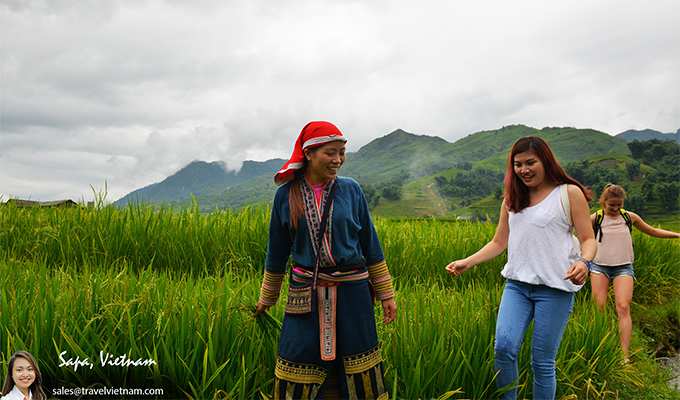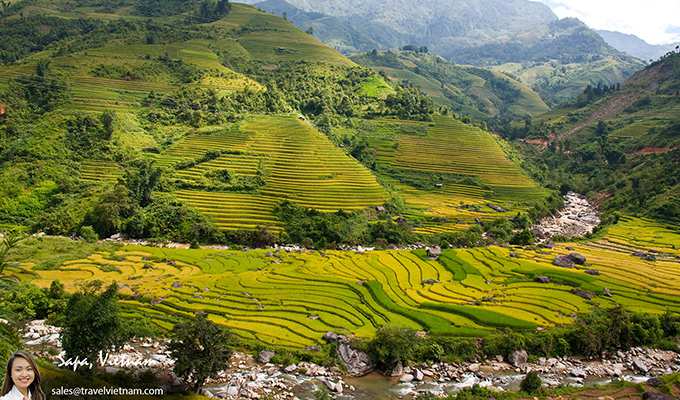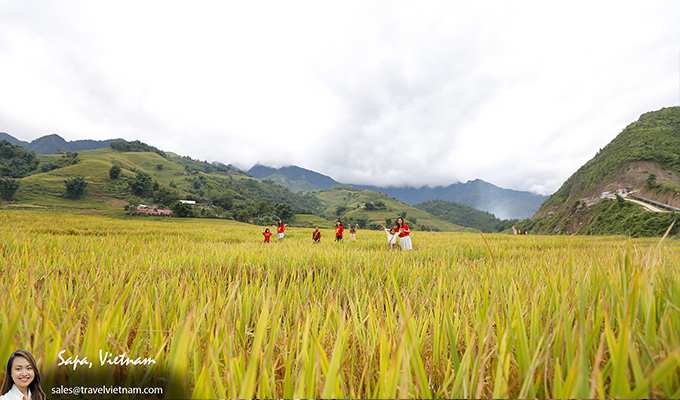
Sapa Vietnam is a small town in the northwest of Vietnam, near the border with China. It is famous for its stunning scenery of mountains, rice terraces, and ethnic minority villages. Sapa is also a great place for trekking, hiking, and exploring the local culture and cuisine. Sapa Vietnam is a destination that will captivate you with its charm, beauty, and diversity.
If you are planning to visit Sapa Vietnam, you may have some questions about this place, such as when is the best time to go, how to get there, what to do, where to stay, and what to expect. This guide will answer all these questions and more, and provide you with useful tips and information to make the most of your Sapa experience. Let's get started!
Key Takeaways:
Sapa is a scenic hill station in northern Vietnam, where you can experience the rich culture and stunning landscapes of the ethnic minority groups. Whether you want to trek through the lush rice terraces, visit the colorful markets, or conquer the highest peak in Indochina, Sapa has something for everyone.
Sapa is a charming town in northern Vietnam, near the border with China. It is famous for its breathtaking views of mountains, rice terraces, and ethnic minority villages.
If you love hiking and nature, trekking in Sapa, Vietnam is a must-do activity. You can explore the stunning scenery of mountains, rice terraces, and ethnic villages, and learn about the diverse cultures of the local people.
A Sapa Tour is a perfect choice for travelers who want to experience the best of Sapa, a charming town in northern Vietnam. You can enjoy the amazing views of mountains, rice terraces, and ethnic villages, and join various activities such as trekking, homestay, sightseeing, and cultural exchange.
Sapa is a hill station in northern Vietnam with a humid subtropical climate and cool temperatures year-round. The weather in Sapa varies from sunny and mild in the dry season (October to April) to rainy and foggy in the wet season (May to September).
The best time to visit Sapa, Vietnam is from March to May or from September to November, when the weather is pleasant and the rice terraces are at their most beautiful. You can also enjoy various festivals and events that showcase the local culture and traditions of the ethnic minority groups.
To get to Sapa, Vietnam, you can choose from different modes of transportation such as train, bus, limousine, or taxi. The most popular and scenic option is to take an overnight train from Hanoi to Lao Cai, and then a taxi or bus to Sapa town.
The ideal duration for your stay in Sapa, Vietnam depends on your preferences and itinerary. However, most travelers recommend spending at least 3-5 days in this scenic region, which allows you to explore the town, the valley, and the mountains.
You can find a variety of handcrafted items such as brocade, silver jewelry, bamboo sticky rice, and local wine. These souvenirs are unique and reflect the rich culture and traditions of the ethnic minority groups in Sapa.
Best Time to Visit Sapa Vietnam

The best time to visit Sapa Vietnam depends on what you want to see and do. Sapa has four seasons: spring, summer, autumn, and winter. Each season has its own advantages and disadvantages, and offers different views and activities. Here is a brief overview of each season:
- Spring (March to May): This is the best time to see the blooming flowers and the green rice fields. The weather is mild and pleasant, with temperatures ranging from 15°C to 25°C. The air is fresh and clear, and the visibility is good. However, this is also the peak season for tourism, so expect higher prices and more crowds. You may also encounter some rain and fog, especially in March and April.
- Summer (June to August): This is the best time to see the ripe rice fields and the harvest festival. The weather is hot and humid, with temperatures ranging from 20°C to 30°C. The air is hazy and dusty, and the visibility is poor. This is also the rainy season, so expect frequent showers and thunderstorms. However, this is also the low season for tourism, so you can enjoy lower prices and fewer crowds. You may also witness some colorful and lively festivals of the ethnic minorities, such as the Gau Tao festival of the Hmong people and the Roong Pooc festival of the Giay people.
- Autumn (September to November): This is the best time to see the golden rice fields and the stunning sunsets. The weather is cool and dry, with temperatures ranging from 10°C to 20°C. The air is crisp and clear, and the visibility is excellent. This is also the best time for trekking and hiking, as the trails are not muddy or slippery. However, this is also the peak season for tourism, so expect higher prices and more crowds. You may also encounter some cold and foggy days, especially in November.
- Winter (December to February): This is the best time to see the snow and the frost. The weather is cold and wet, with temperatures ranging from 0°C to 10°C. The air is misty and cloudy, and the visibility is low. This is also the best time to see the peach and plum blossoms, which add a touch of color and warmth to the landscape. However, this is also the low season for tourism, so you can enjoy lower prices and fewer crowds. You may also experience some snow and frost, which can make the roads and trails slippery and dangerous.
How to Get to Sapa Vietnam

There are several ways to get to Sapa Vietnam from Hanoi, the capital city of Vietnam. The most common ways are by bus, train, or car. Here is a comparison of each option:
- Bus: Taking a bus is the cheapest and fastest way to get to Sapa Vietnam. There are many bus companies that offer daily services from Hanoi to Sapa, with different departure times and prices. The bus journey takes about 5 to 6 hours, depending on the traffic and the weather. The bus ticket costs around 10 to 15 USD per person, depending on the quality and comfort of the bus. The bus will drop you off at the Sapa bus station, which is about 1 km from the town center. You can then take a taxi or a motorbike to your hotel or hostel.
- Train: Taking a train is the most comfortable and scenic way to get to Sapa Vietnam. There are several train companies that offer overnight services from Hanoi to Lao Cai, the nearest city to Sapa. The train journey takes about 8 to 9 hours, and you can choose from different types of cabins, such as soft sleeper, hard sleeper, or VIP. The train ticket costs around 20 to 40 USD per person, depending on the type and quality of the cabin. The train will arrive at the Lao Cai train station, which is about 35 km from Sapa. You can then take a bus, a taxi, or a private car to Sapa, which will cost around 5 to 10 USD per person and take about an hour.
- Car: Renting a car or hiring a driver is the most convenient and flexible way to get to Sapa Vietnam. You can choose your own departure time and stop along the way to enjoy the views and the attractions. The car journey takes about 4 to 5 hours, depending on the traffic and the weather. The car rental or driver fee costs around 100 to 150 USD per car, depending on the type and size of the car. The car will take you directly to your hotel or hostel in Sapa.
What to Do in Sapa Vietnam
There are many things to do in Sapa Vietnam, depending on your interests and preferences. Here are some of the most popular and recommended activities:
- Trekking: Trekking is the main attraction and activity in Sapa Vietnam, as it allows you to explore the stunning scenery of the mountains, the rice terraces, and the ethnic minority villages. You can choose from different levels of difficulty and duration, from easy to hard, and from half-day to multi-day. You can also choose to trek independently or with a local guide, who can share with you the stories and the culture of the area. Some of the most famous and beautiful trekking routes are the Cat Cat village, the Y Linh Ho village, the Lao Chai village, the Ta Van village, the Giang Ta Chai village, and the Ta Phin village. You can also book a trekking tour package, which will include transportation, accommodation, meals, and guide services.
- Homestay: Homestay is another popular and rewarding activity in Sapa Vietnam, as it allows you to experience the authentic and hospitable lifestyle of the ethnic minority people. You can stay overnight in a traditional stilt house or a bamboo hut, and share meals and stories with the host family. You can also join them in their daily activities, such as farming, cooking, weaving, or dancing. Homestay is a great way to learn more about the culture and the customs of the area, and to make some new friends. You can find homestay options in most of the ethnic minority villages, such as the Hmong, the Dao, the Tay, the Giay, or the Nung. You can also book a homestay tour package, which will include transportation, accommodation, meals, and guide services.
- Fansipan: Fansipan is the highest peak in Vietnam and Indochina, with an altitude of 3,143 meters. It is also known as the Roof of Indochina, and offers spectacular views of the surrounding mountains and valleys. Fansipan is a challenging and rewarding destination for adventure seekers, who can choose to climb to the summit by foot or by cable car. Climbing by foot takes about 2 to 3 days, depending on your fitness level and the weather. You will need to hire a local guide, a porter, and a permit, and bring your own equipment and supplies. Climbing by cable car takes about 15 to 20 minutes, and is the easiest and fastest way to reach the top. You will need to buy a cable car ticket, which costs around 30 to 40 USD per person. You can also visit the Fansipan Legend complex, which features a pagoda, a temple, a garden, and a statue of Buddha.
- Markets: Markets are another interesting and fun activity in Sapa Vietnam, as they showcase the diversity and the vibrancy of the local people and products. You can find different types of markets in Sapa, such as the daily markets, the weekly markets, and the love markets. The daily markets are open every day in the town center, and sell various goods, such as food, clothes, souvenirs, and handicrafts. The weekly markets are open on specific days in different locations, and attract people from different ethnic groups, who come to trade, socialize, and enjoy. Some of the most famous weekly markets are the Bac Ha market, the Coc Ly market, the Can Cau market, and the Muong Hum market. The love markets are open on Saturday nights in the town center, and are a unique and romantic tradition of the Hmong people, who come to find their partners, sing, and dance.
Where to Stay in Sapa Vietnam
There are many options for accommodation in Sapa Vietnam, ranging from budget to luxury, and from hotels to homestays. Here are some of the most popular and recommended places to stay:
- Sapa Centre Hotel: This is a 3-star hotel located in the heart of Sapa town, near the church and the lake. It offers comfortable and cozy rooms with modern amenities, such as air conditioning, TV, Wi-Fi, and private bathroom. The hotel also has a restaurant, a bar, a spa, and a tour desk. The hotel is rated 4.5 out of 5 on TripAdvisor, and the price ranges from 20 to 40 USD per night.
- Sapa Clay House: This is a 4-star hotel located in the Ta Van village, about 10 km from Sapa town. It offers spacious and elegant rooms with traditional decor, such as clay walls, wooden furniture, and bamboo lamps. The rooms also have modern amenities, such as air conditioning, TV, Wi-Fi, and private bathroom. The hotel also has a restaurant, a pool, a garden, and a terrace. The hotel is rated 4.5 out of 5 on TripAdvisor, and the price ranges from 50 to 80 USD per night.
- Topas Ecolodge: This is a 5-star hotel located in the Ban Lach village, about 18 km from Sapa town. It offers luxurious and eco-friendly bungalows with panoramic views of the mountains and the valleys. The bungalows also have modern amenities, such as air conditioning, TV, Wi-Fi, and private bathroom. The hotel also has a restaurant, a bar, a spa, and a pool. The hotel is rated 4.5 out of 5 on TripAdvisor, and the price ranges from 100 to 200 USD per night.
- Sapa Homestay: This is a budget option for travelers who want to experience the authentic and hospitable lifestyle of the ethnic minority people. You can stay overnight in a traditional stilt house or a bamboo hut, and share meals and stories with the host family. You can also join them in their daily activities, such as farming, cooking, weaving, or dancing. Homestay is a great way to learn more about the culture and the customs of the area, and to make some new friends. You can find homestay options in most of the ethnic minority villages, such as the Hmong, the Dao, the Tay, the Giay, or the Nung. The price ranges from 5 to 15 USD per night, depending on the location and the quality of the homestay.
Sapa Vietnam is a beautiful destination for travelers who love nature, culture, and adventure. This guide has provided you with some useful tips and information to help you plan your trip to Sapa, such as the best time to visit, how to get there, what to do, and where to stay. We hope that this guide has inspired you to visit Sapa and discover its charm, beauty, and diversity. Sapa Vietnam is a place that will captivate you with its scenery, its people, and its cuisine. It is a place that you will never forget.
Last updated on 2024-02-22 08:40:51.
Other Blog
- Vietnam Tourism: Where to Go, What to See, and How to Plan Your Trip
- 10 Reasons to fall in love with Vietnam
- Romantic Getaways and Honeymoons in Vietnam
- Son Doong - World’s Largest Cave
- Speedboat to Con Dao Island from Soc Trang
- Vietnam: an Aerial Concert
- Chu Chi tunnels or Cu Chi tunnels?
- Vietnam Weather and Climate: A Guide to the Best Time to Visit
- Vietnamese Kite With Flutes (Dieu Sao)
- 17 Vietnam Villages you should not miss to unravel Vietnamese traditional lifestyle

